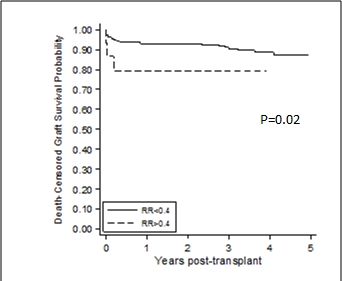Renal Resistance Measured During Pulsatile Perfusion and Long-Term Kidney Transplant Outcomes
McGill University Health Center, Montreal, QC, Canada.
Meeting: 2015 American Transplant Congress
Abstract number: B120
Keywords: Graft survival, Kidney transplantation, Pulsatile preservation, Survival
Session Information
Session Name: Poster Session B: Kidney Complications: Late Graft Failure
Session Type: Poster Session
Date: Sunday, May 3, 2015
Session Time: 5:30pm-6:30pm
 Presentation Time: 5:30pm-6:30pm
Presentation Time: 5:30pm-6:30pm
Location: Exhibit Hall E
Background: Pulsatile perfusion (PP) has been shown to reduce the incidence of delayed graft function (DGF) and increase short- and long-term kidney transplant (KT) survival. Renal resistance (RR) exceeding 0.4 mmHg/mL/min measured at the end of PP has been linked with inferior 1-year graft survival. The purpose of this study was to evaluate the association between RR and long-term KT outcomes.
Methods: We conducted a retrospective cohort study including adult deceased-donor KT recipients transplanted at McGill University Health Centre (12/2007 to 10/2013) whose grafts underwent PP. Multi-organ transplant recipients were excluded. The relationship between the mean RR measured over the last 15 minutes of PP and death-censored graft survival (DCGS) was assessed using Kaplan-Meier (KM) curves and Cox proportional hazards models. RR was modeled as a binary variable with a threshold of 0.4 mmHg/mL/min. All-cause mortality and graft failure were secondary endpoints.
Results: Of 274 eligible KT recipients, 59.1% underwent transplantation from expanded criteria donors (ECD) and 8% from donors after cardiac death. Sixty six (24.1%) patients experienced DGF. Over a median follow up of 2.9 years (inter-quartile range: 3.3 years), a total of 28 (10.2%) graft failures and 26 (9.5%) deaths with a functioning graft, were observed. KM curves for DCGS, in patients with RR ≥0.4 vs. RR <0.4 mmHg/mL/min is presented in Figure1. Graft failure and all-cause mortality were not statistically significant (logrank test: p=0.41 and p=0.24, respectively). Hazard ratios [95% CI] of 3.23 [95% CI: 1.12, 9.34. p=0.03) and 2.67 [95% CI: 0.91, 7.86. p=0.07) were observed for DCGS in univariable and multivariable Cox proportional hazards models adjusting for ECD status, cold ischemia time, and recipient age at transplantation, respectively. 
Conclusions: In this single center study, RR was associated with inferior DCGS. This effect diminished when accounting for donor and recipient characteristics. The added role of RR in predicting long-term KT outcomes and whether a particular RR threshold could inform organ utilization choices should be evaluated in multicenter studies.
To cite this abstract in AMA style:
Sandal S, Sapir-Pichhadze R, Cantarovich M, Paraskevas S. Renal Resistance Measured During Pulsatile Perfusion and Long-Term Kidney Transplant Outcomes [abstract]. Am J Transplant. 2015; 15 (suppl 3). https://atcmeetingabstracts.com/abstract/renal-resistance-measured-during-pulsatile-perfusion-and-long-term-kidney-transplant-outcomes/. Accessed December 7, 2025.« Back to 2015 American Transplant Congress
